Comprehensive Epidemiological Study on HIV Infection in the US
VerifiedAdded on 2022/08/13
|12
|2992
|15
Report
AI Summary
This report provides a comprehensive epidemiological study on HIV infection in the United States. It begins with an introduction to HIV/AIDS, discussing the disease's prevalence, mortality rates, modes of transmission, and initial symptoms. The study then delves into the social determinants of health, such as poverty, education, and employment, and their impact on HIV infection rates. The epidemiologic triangle, encompassing agent, host, and environmental factors, is analyzed in the context of HIV. The report also outlines the crucial role of the community health nurse in case finding, reporting, data collection, and providing support to patients, including addressing social stigma and psychological needs. Furthermore, it examines the roles of national agencies like the CDC in combating the disease through various initiatives, including antiretroviral therapy and awareness programs. Finally, the report touches upon the global implications of HIV and the WHO's efforts in addressing the disease worldwide, summarizing key findings and insights from the study.

Running head: EPIDEMIOLOGICAL STUDY ON HIV INFECTION IN US
Epidemiological Study on HIV infection in US
Name of the Student
Name of the University
Author Note
Epidemiological Study on HIV infection in US
Name of the Student
Name of the University
Author Note
Paraphrase This Document
Need a fresh take? Get an instant paraphrase of this document with our AI Paraphraser
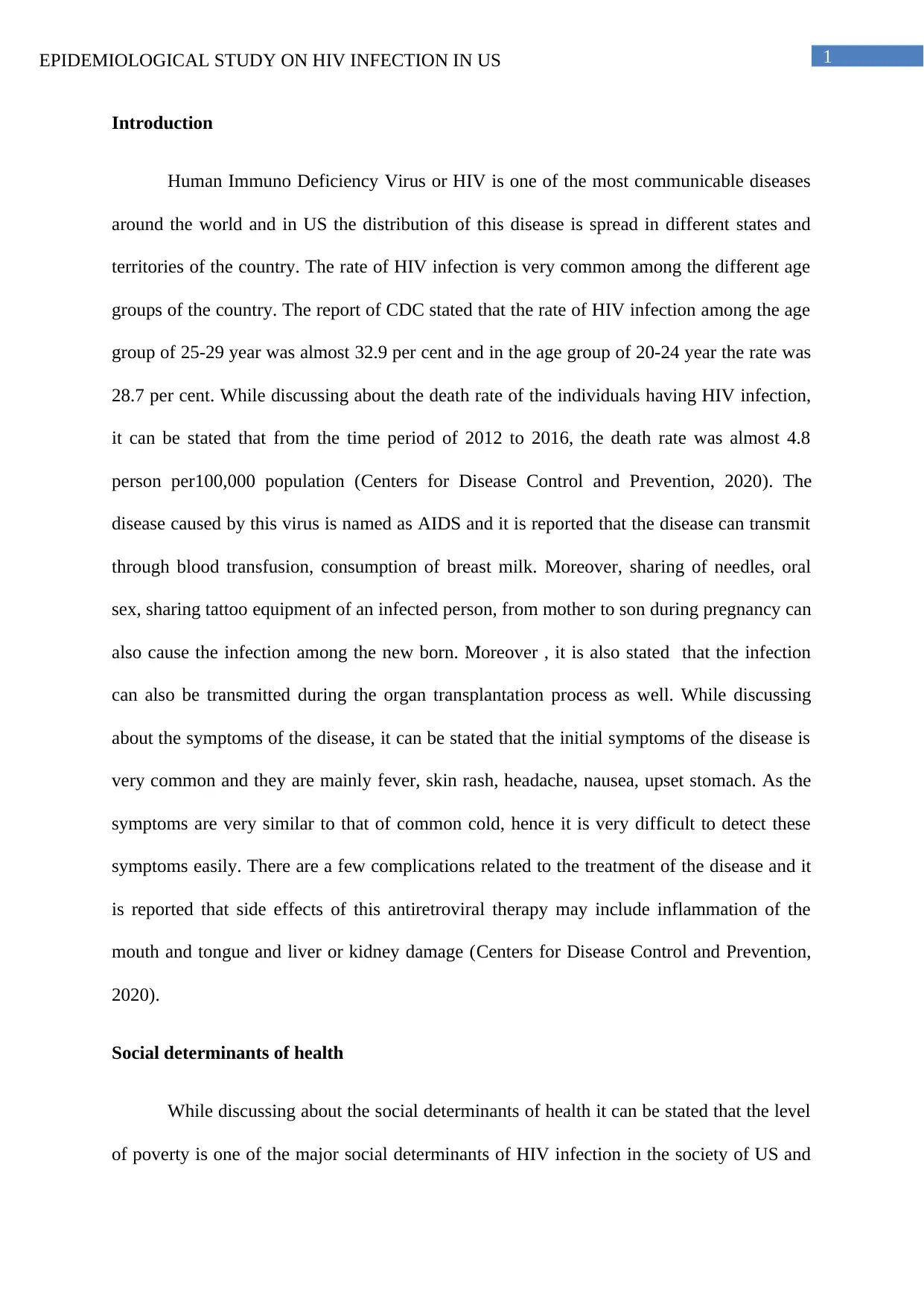
1EPIDEMIOLOGICAL STUDY ON HIV INFECTION IN US
Introduction
Human Immuno Deficiency Virus or HIV is one of the most communicable diseases
around the world and in US the distribution of this disease is spread in different states and
territories of the country. The rate of HIV infection is very common among the different age
groups of the country. The report of CDC stated that the rate of HIV infection among the age
group of 25-29 year was almost 32.9 per cent and in the age group of 20-24 year the rate was
28.7 per cent. While discussing about the death rate of the individuals having HIV infection,
it can be stated that from the time period of 2012 to 2016, the death rate was almost 4.8
person per100,000 population (Centers for Disease Control and Prevention, 2020). The
disease caused by this virus is named as AIDS and it is reported that the disease can transmit
through blood transfusion, consumption of breast milk. Moreover, sharing of needles, oral
sex, sharing tattoo equipment of an infected person, from mother to son during pregnancy can
also cause the infection among the new born. Moreover , it is also stated that the infection
can also be transmitted during the organ transplantation process as well. While discussing
about the symptoms of the disease, it can be stated that the initial symptoms of the disease is
very common and they are mainly fever, skin rash, headache, nausea, upset stomach. As the
symptoms are very similar to that of common cold, hence it is very difficult to detect these
symptoms easily. There are a few complications related to the treatment of the disease and it
is reported that side effects of this antiretroviral therapy may include inflammation of the
mouth and tongue and liver or kidney damage (Centers for Disease Control and Prevention,
2020).
Social determinants of health
While discussing about the social determinants of health it can be stated that the level
of poverty is one of the major social determinants of HIV infection in the society of US and
Introduction
Human Immuno Deficiency Virus or HIV is one of the most communicable diseases
around the world and in US the distribution of this disease is spread in different states and
territories of the country. The rate of HIV infection is very common among the different age
groups of the country. The report of CDC stated that the rate of HIV infection among the age
group of 25-29 year was almost 32.9 per cent and in the age group of 20-24 year the rate was
28.7 per cent. While discussing about the death rate of the individuals having HIV infection,
it can be stated that from the time period of 2012 to 2016, the death rate was almost 4.8
person per100,000 population (Centers for Disease Control and Prevention, 2020). The
disease caused by this virus is named as AIDS and it is reported that the disease can transmit
through blood transfusion, consumption of breast milk. Moreover, sharing of needles, oral
sex, sharing tattoo equipment of an infected person, from mother to son during pregnancy can
also cause the infection among the new born. Moreover , it is also stated that the infection
can also be transmitted during the organ transplantation process as well. While discussing
about the symptoms of the disease, it can be stated that the initial symptoms of the disease is
very common and they are mainly fever, skin rash, headache, nausea, upset stomach. As the
symptoms are very similar to that of common cold, hence it is very difficult to detect these
symptoms easily. There are a few complications related to the treatment of the disease and it
is reported that side effects of this antiretroviral therapy may include inflammation of the
mouth and tongue and liver or kidney damage (Centers for Disease Control and Prevention,
2020).
Social determinants of health
While discussing about the social determinants of health it can be stated that the level
of poverty is one of the major social determinants of HIV infection in the society of US and
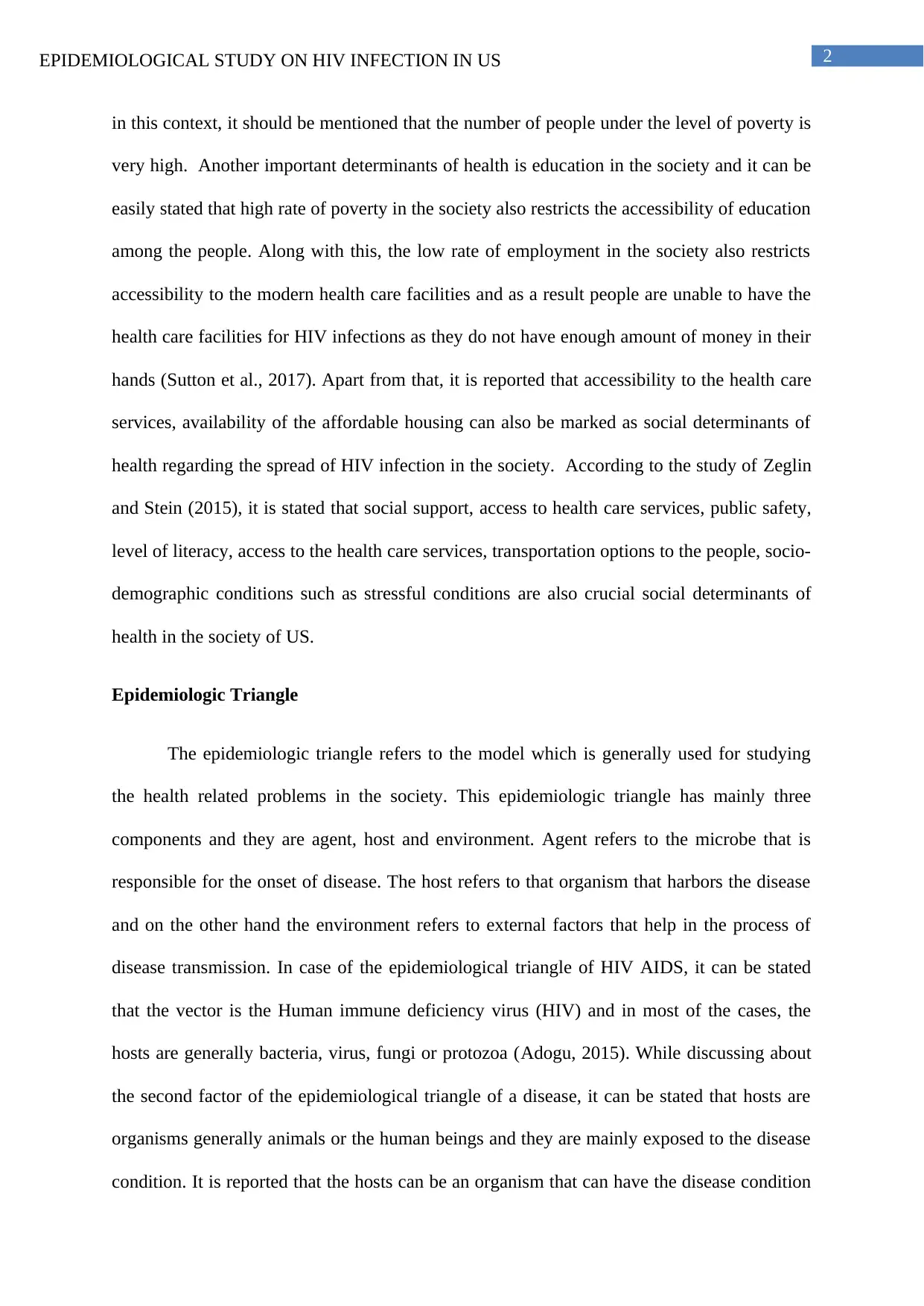
2EPIDEMIOLOGICAL STUDY ON HIV INFECTION IN US
in this context, it should be mentioned that the number of people under the level of poverty is
very high. Another important determinants of health is education in the society and it can be
easily stated that high rate of poverty in the society also restricts the accessibility of education
among the people. Along with this, the low rate of employment in the society also restricts
accessibility to the modern health care facilities and as a result people are unable to have the
health care facilities for HIV infections as they do not have enough amount of money in their
hands (Sutton et al., 2017). Apart from that, it is reported that accessibility to the health care
services, availability of the affordable housing can also be marked as social determinants of
health regarding the spread of HIV infection in the society. According to the study of Zeglin
and Stein (2015), it is stated that social support, access to health care services, public safety,
level of literacy, access to the health care services, transportation options to the people, socio-
demographic conditions such as stressful conditions are also crucial social determinants of
health in the society of US.
Epidemiologic Triangle
The epidemiologic triangle refers to the model which is generally used for studying
the health related problems in the society. This epidemiologic triangle has mainly three
components and they are agent, host and environment. Agent refers to the microbe that is
responsible for the onset of disease. The host refers to that organism that harbors the disease
and on the other hand the environment refers to external factors that help in the process of
disease transmission. In case of the epidemiological triangle of HIV AIDS, it can be stated
that the vector is the Human immune deficiency virus (HIV) and in most of the cases, the
hosts are generally bacteria, virus, fungi or protozoa (Adogu, 2015). While discussing about
the second factor of the epidemiological triangle of a disease, it can be stated that hosts are
organisms generally animals or the human beings and they are mainly exposed to the disease
condition. It is reported that the hosts can be an organism that can have the disease condition
in this context, it should be mentioned that the number of people under the level of poverty is
very high. Another important determinants of health is education in the society and it can be
easily stated that high rate of poverty in the society also restricts the accessibility of education
among the people. Along with this, the low rate of employment in the society also restricts
accessibility to the modern health care facilities and as a result people are unable to have the
health care facilities for HIV infections as they do not have enough amount of money in their
hands (Sutton et al., 2017). Apart from that, it is reported that accessibility to the health care
services, availability of the affordable housing can also be marked as social determinants of
health regarding the spread of HIV infection in the society. According to the study of Zeglin
and Stein (2015), it is stated that social support, access to health care services, public safety,
level of literacy, access to the health care services, transportation options to the people, socio-
demographic conditions such as stressful conditions are also crucial social determinants of
health in the society of US.
Epidemiologic Triangle
The epidemiologic triangle refers to the model which is generally used for studying
the health related problems in the society. This epidemiologic triangle has mainly three
components and they are agent, host and environment. Agent refers to the microbe that is
responsible for the onset of disease. The host refers to that organism that harbors the disease
and on the other hand the environment refers to external factors that help in the process of
disease transmission. In case of the epidemiological triangle of HIV AIDS, it can be stated
that the vector is the Human immune deficiency virus (HIV) and in most of the cases, the
hosts are generally bacteria, virus, fungi or protozoa (Adogu, 2015). While discussing about
the second factor of the epidemiological triangle of a disease, it can be stated that hosts are
organisms generally animals or the human beings and they are mainly exposed to the disease
condition. It is reported that the hosts can be an organism that can have the disease condition
⊘ This is a preview!⊘
Do you want full access?
Subscribe today to unlock all pages.

Trusted by 1+ million students worldwide
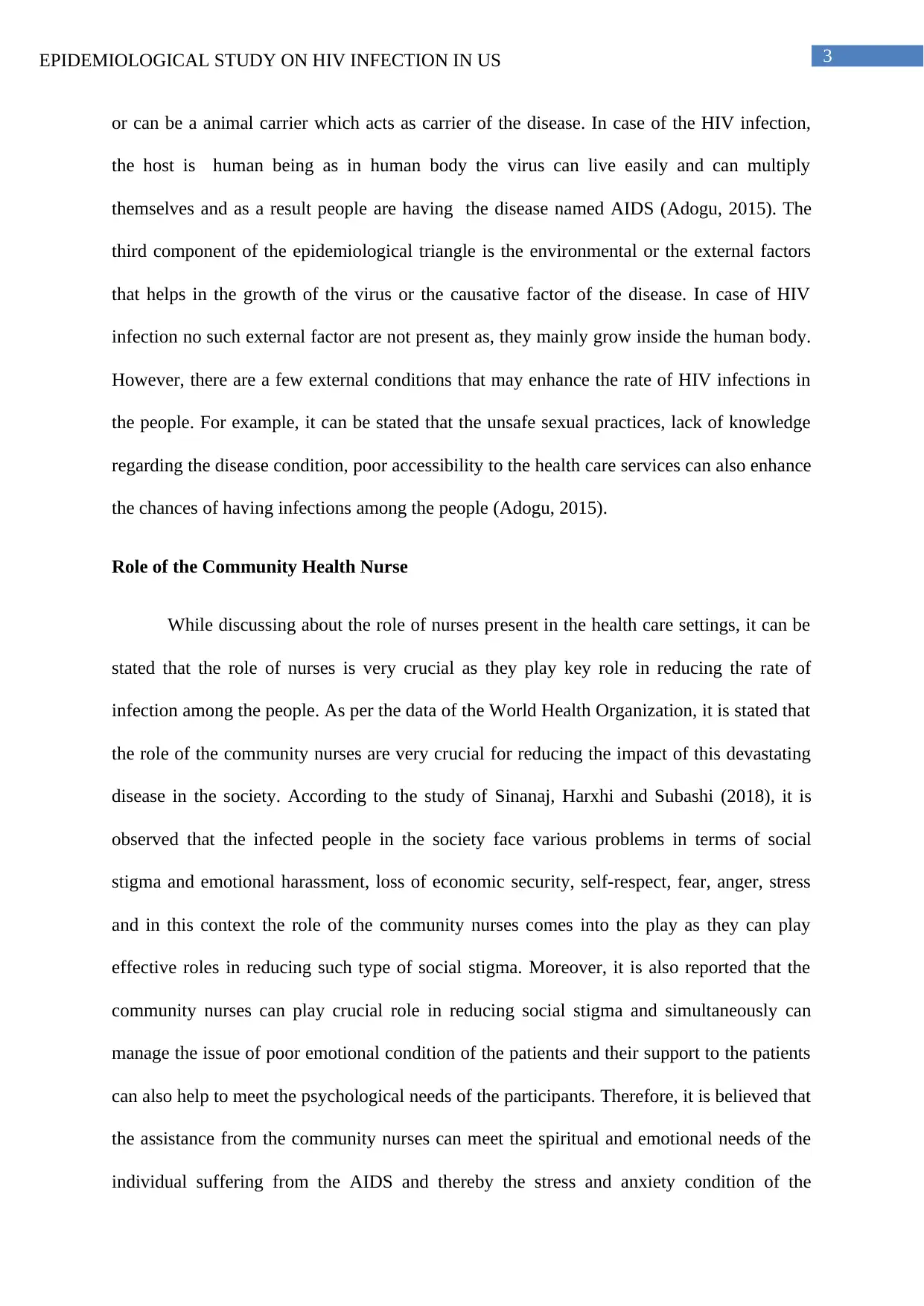
3EPIDEMIOLOGICAL STUDY ON HIV INFECTION IN US
or can be a animal carrier which acts as carrier of the disease. In case of the HIV infection,
the host is human being as in human body the virus can live easily and can multiply
themselves and as a result people are having the disease named AIDS (Adogu, 2015). The
third component of the epidemiological triangle is the environmental or the external factors
that helps in the growth of the virus or the causative factor of the disease. In case of HIV
infection no such external factor are not present as, they mainly grow inside the human body.
However, there are a few external conditions that may enhance the rate of HIV infections in
the people. For example, it can be stated that the unsafe sexual practices, lack of knowledge
regarding the disease condition, poor accessibility to the health care services can also enhance
the chances of having infections among the people (Adogu, 2015).
Role of the Community Health Nurse
While discussing about the role of nurses present in the health care settings, it can be
stated that the role of nurses is very crucial as they play key role in reducing the rate of
infection among the people. As per the data of the World Health Organization, it is stated that
the role of the community nurses are very crucial for reducing the impact of this devastating
disease in the society. According to the study of Sinanaj, Harxhi and Subashi (2018), it is
observed that the infected people in the society face various problems in terms of social
stigma and emotional harassment, loss of economic security, self-respect, fear, anger, stress
and in this context the role of the community nurses comes into the play as they can play
effective roles in reducing such type of social stigma. Moreover, it is also reported that the
community nurses can play crucial role in reducing social stigma and simultaneously can
manage the issue of poor emotional condition of the patients and their support to the patients
can also help to meet the psychological needs of the participants. Therefore, it is believed that
the assistance from the community nurses can meet the spiritual and emotional needs of the
individual suffering from the AIDS and thereby the stress and anxiety condition of the
or can be a animal carrier which acts as carrier of the disease. In case of the HIV infection,
the host is human being as in human body the virus can live easily and can multiply
themselves and as a result people are having the disease named AIDS (Adogu, 2015). The
third component of the epidemiological triangle is the environmental or the external factors
that helps in the growth of the virus or the causative factor of the disease. In case of HIV
infection no such external factor are not present as, they mainly grow inside the human body.
However, there are a few external conditions that may enhance the rate of HIV infections in
the people. For example, it can be stated that the unsafe sexual practices, lack of knowledge
regarding the disease condition, poor accessibility to the health care services can also enhance
the chances of having infections among the people (Adogu, 2015).
Role of the Community Health Nurse
While discussing about the role of nurses present in the health care settings, it can be
stated that the role of nurses is very crucial as they play key role in reducing the rate of
infection among the people. As per the data of the World Health Organization, it is stated that
the role of the community nurses are very crucial for reducing the impact of this devastating
disease in the society. According to the study of Sinanaj, Harxhi and Subashi (2018), it is
observed that the infected people in the society face various problems in terms of social
stigma and emotional harassment, loss of economic security, self-respect, fear, anger, stress
and in this context the role of the community nurses comes into the play as they can play
effective roles in reducing such type of social stigma. Moreover, it is also reported that the
community nurses can play crucial role in reducing social stigma and simultaneously can
manage the issue of poor emotional condition of the patients and their support to the patients
can also help to meet the psychological needs of the participants. Therefore, it is believed that
the assistance from the community nurses can meet the spiritual and emotional needs of the
individual suffering from the AIDS and thereby the stress and anxiety condition of the
Paraphrase This Document
Need a fresh take? Get an instant paraphrase of this document with our AI Paraphraser
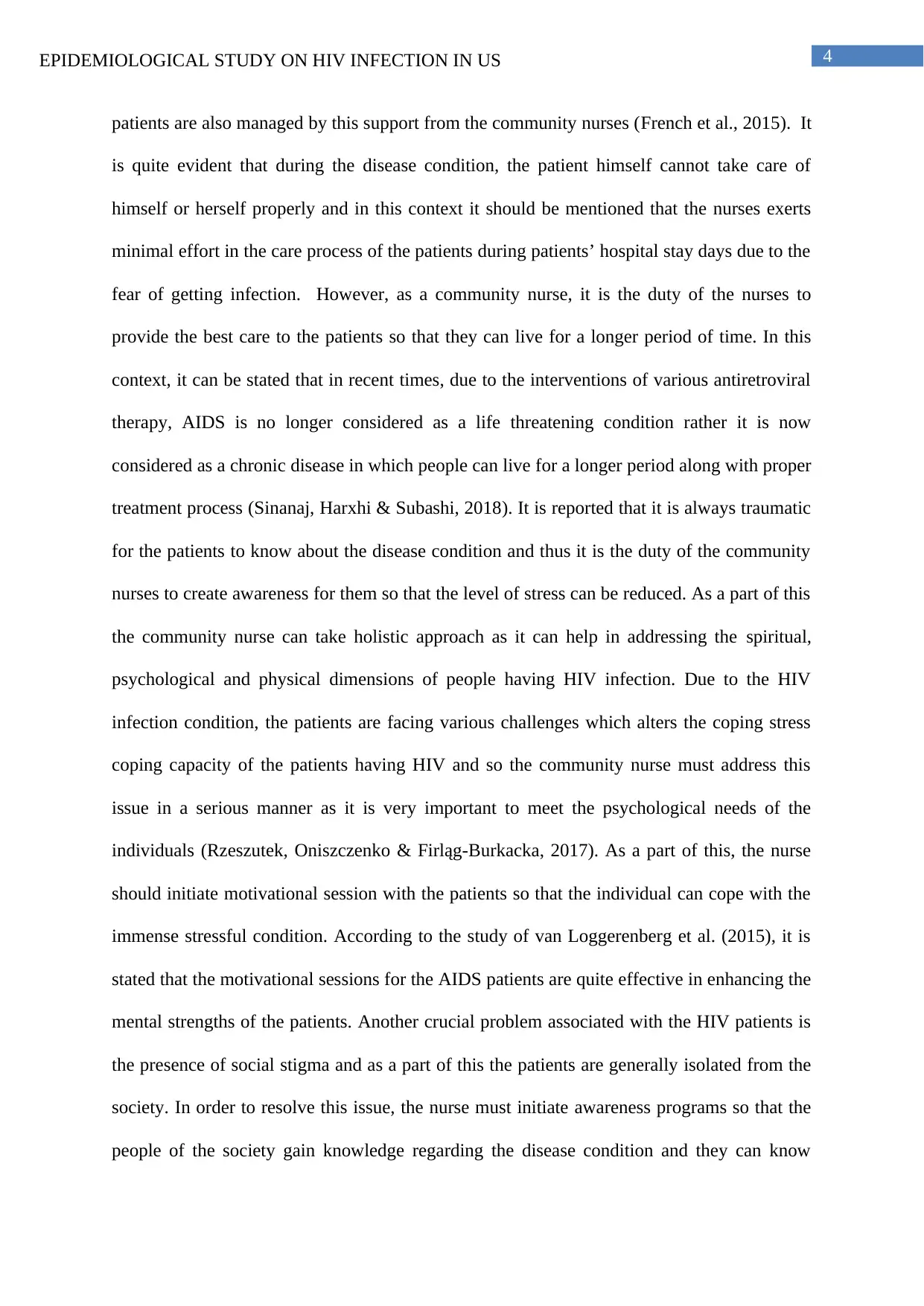
4EPIDEMIOLOGICAL STUDY ON HIV INFECTION IN US
patients are also managed by this support from the community nurses (French et al., 2015). It
is quite evident that during the disease condition, the patient himself cannot take care of
himself or herself properly and in this context it should be mentioned that the nurses exerts
minimal effort in the care process of the patients during patients’ hospital stay days due to the
fear of getting infection. However, as a community nurse, it is the duty of the nurses to
provide the best care to the patients so that they can live for a longer period of time. In this
context, it can be stated that in recent times, due to the interventions of various antiretroviral
therapy, AIDS is no longer considered as a life threatening condition rather it is now
considered as a chronic disease in which people can live for a longer period along with proper
treatment process (Sinanaj, Harxhi & Subashi, 2018). It is reported that it is always traumatic
for the patients to know about the disease condition and thus it is the duty of the community
nurses to create awareness for them so that the level of stress can be reduced. As a part of this
the community nurse can take holistic approach as it can help in addressing the spiritual,
psychological and physical dimensions of people having HIV infection. Due to the HIV
infection condition, the patients are facing various challenges which alters the coping stress
coping capacity of the patients having HIV and so the community nurse must address this
issue in a serious manner as it is very important to meet the psychological needs of the
individuals (Rzeszutek, Oniszczenko & Firląg-Burkacka, 2017). As a part of this, the nurse
should initiate motivational session with the patients so that the individual can cope with the
immense stressful condition. According to the study of van Loggerenberg et al. (2015), it is
stated that the motivational sessions for the AIDS patients are quite effective in enhancing the
mental strengths of the patients. Another crucial problem associated with the HIV patients is
the presence of social stigma and as a part of this the patients are generally isolated from the
society. In order to resolve this issue, the nurse must initiate awareness programs so that the
people of the society gain knowledge regarding the disease condition and they can know
patients are also managed by this support from the community nurses (French et al., 2015). It
is quite evident that during the disease condition, the patient himself cannot take care of
himself or herself properly and in this context it should be mentioned that the nurses exerts
minimal effort in the care process of the patients during patients’ hospital stay days due to the
fear of getting infection. However, as a community nurse, it is the duty of the nurses to
provide the best care to the patients so that they can live for a longer period of time. In this
context, it can be stated that in recent times, due to the interventions of various antiretroviral
therapy, AIDS is no longer considered as a life threatening condition rather it is now
considered as a chronic disease in which people can live for a longer period along with proper
treatment process (Sinanaj, Harxhi & Subashi, 2018). It is reported that it is always traumatic
for the patients to know about the disease condition and thus it is the duty of the community
nurses to create awareness for them so that the level of stress can be reduced. As a part of this
the community nurse can take holistic approach as it can help in addressing the spiritual,
psychological and physical dimensions of people having HIV infection. Due to the HIV
infection condition, the patients are facing various challenges which alters the coping stress
coping capacity of the patients having HIV and so the community nurse must address this
issue in a serious manner as it is very important to meet the psychological needs of the
individuals (Rzeszutek, Oniszczenko & Firląg-Burkacka, 2017). As a part of this, the nurse
should initiate motivational session with the patients so that the individual can cope with the
immense stressful condition. According to the study of van Loggerenberg et al. (2015), it is
stated that the motivational sessions for the AIDS patients are quite effective in enhancing the
mental strengths of the patients. Another crucial problem associated with the HIV patients is
the presence of social stigma and as a part of this the patients are generally isolated from the
society. In order to resolve this issue, the nurse must initiate awareness programs so that the
people of the society gain knowledge regarding the disease condition and they can know
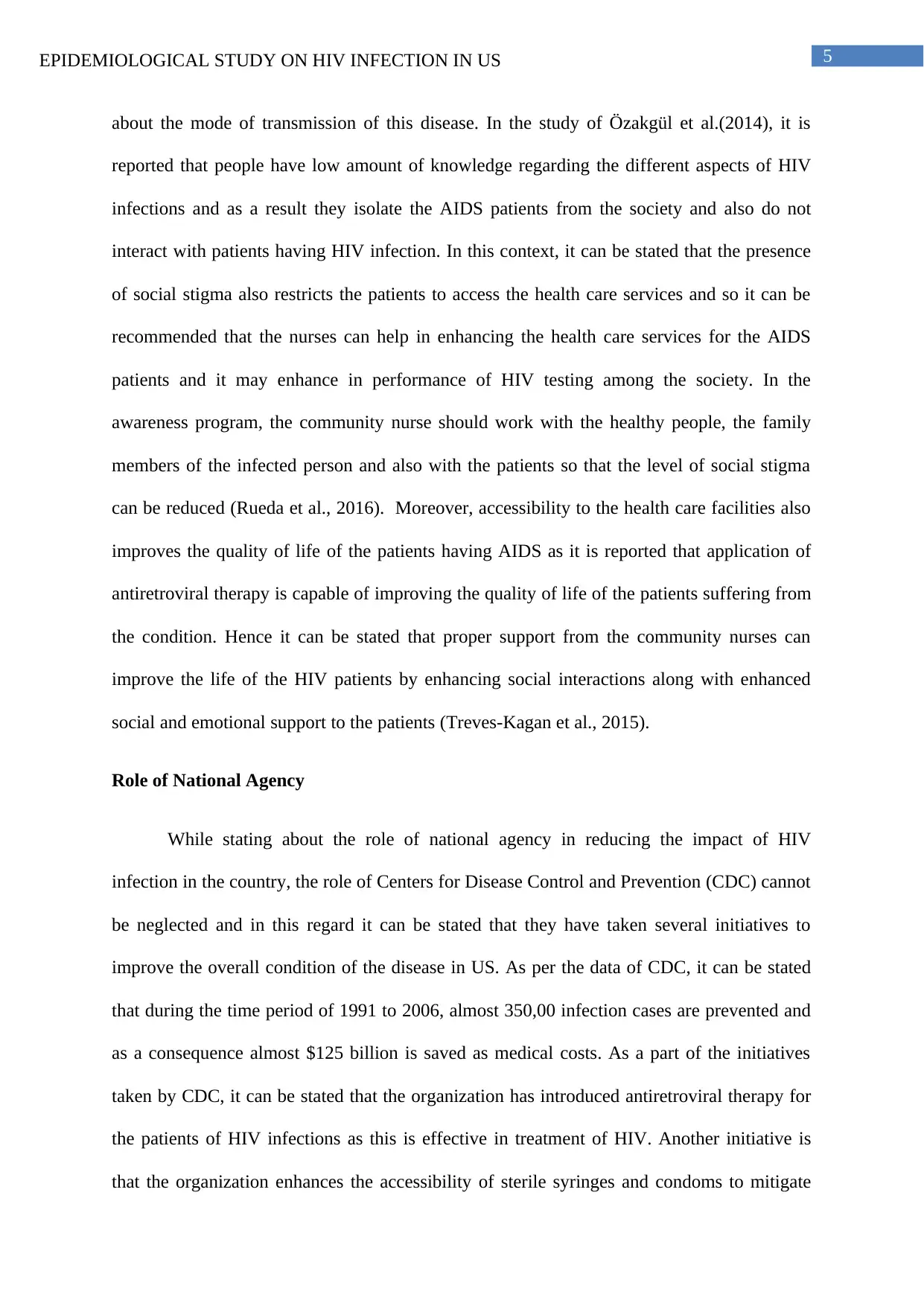
5EPIDEMIOLOGICAL STUDY ON HIV INFECTION IN US
about the mode of transmission of this disease. In the study of Özakgül et al.(2014), it is
reported that people have low amount of knowledge regarding the different aspects of HIV
infections and as a result they isolate the AIDS patients from the society and also do not
interact with patients having HIV infection. In this context, it can be stated that the presence
of social stigma also restricts the patients to access the health care services and so it can be
recommended that the nurses can help in enhancing the health care services for the AIDS
patients and it may enhance in performance of HIV testing among the society. In the
awareness program, the community nurse should work with the healthy people, the family
members of the infected person and also with the patients so that the level of social stigma
can be reduced (Rueda et al., 2016). Moreover, accessibility to the health care facilities also
improves the quality of life of the patients having AIDS as it is reported that application of
antiretroviral therapy is capable of improving the quality of life of the patients suffering from
the condition. Hence it can be stated that proper support from the community nurses can
improve the life of the HIV patients by enhancing social interactions along with enhanced
social and emotional support to the patients (Treves-Kagan et al., 2015).
Role of National Agency
While stating about the role of national agency in reducing the impact of HIV
infection in the country, the role of Centers for Disease Control and Prevention (CDC) cannot
be neglected and in this regard it can be stated that they have taken several initiatives to
improve the overall condition of the disease in US. As per the data of CDC, it can be stated
that during the time period of 1991 to 2006, almost 350,00 infection cases are prevented and
as a consequence almost $125 billion is saved as medical costs. As a part of the initiatives
taken by CDC, it can be stated that the organization has introduced antiretroviral therapy for
the patients of HIV infections as this is effective in treatment of HIV. Another initiative is
that the organization enhances the accessibility of sterile syringes and condoms to mitigate
about the mode of transmission of this disease. In the study of Özakgül et al.(2014), it is
reported that people have low amount of knowledge regarding the different aspects of HIV
infections and as a result they isolate the AIDS patients from the society and also do not
interact with patients having HIV infection. In this context, it can be stated that the presence
of social stigma also restricts the patients to access the health care services and so it can be
recommended that the nurses can help in enhancing the health care services for the AIDS
patients and it may enhance in performance of HIV testing among the society. In the
awareness program, the community nurse should work with the healthy people, the family
members of the infected person and also with the patients so that the level of social stigma
can be reduced (Rueda et al., 2016). Moreover, accessibility to the health care facilities also
improves the quality of life of the patients having AIDS as it is reported that application of
antiretroviral therapy is capable of improving the quality of life of the patients suffering from
the condition. Hence it can be stated that proper support from the community nurses can
improve the life of the HIV patients by enhancing social interactions along with enhanced
social and emotional support to the patients (Treves-Kagan et al., 2015).
Role of National Agency
While stating about the role of national agency in reducing the impact of HIV
infection in the country, the role of Centers for Disease Control and Prevention (CDC) cannot
be neglected and in this regard it can be stated that they have taken several initiatives to
improve the overall condition of the disease in US. As per the data of CDC, it can be stated
that during the time period of 1991 to 2006, almost 350,00 infection cases are prevented and
as a consequence almost $125 billion is saved as medical costs. As a part of the initiatives
taken by CDC, it can be stated that the organization has introduced antiretroviral therapy for
the patients of HIV infections as this is effective in treatment of HIV. Another initiative is
that the organization enhances the accessibility of sterile syringes and condoms to mitigate
⊘ This is a preview!⊘
Do you want full access?
Subscribe today to unlock all pages.

Trusted by 1+ million students worldwide
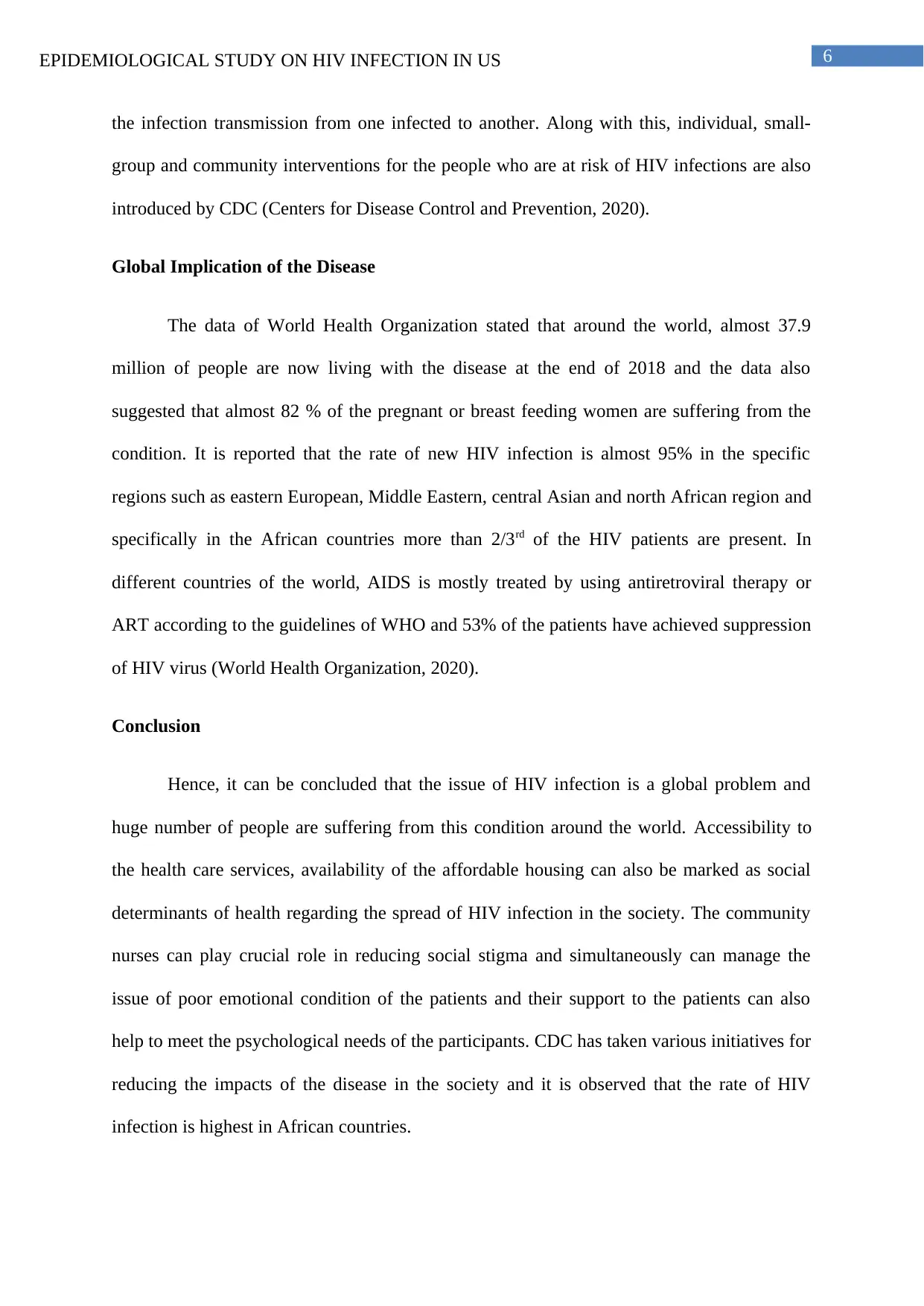
6EPIDEMIOLOGICAL STUDY ON HIV INFECTION IN US
the infection transmission from one infected to another. Along with this, individual, small-
group and community interventions for the people who are at risk of HIV infections are also
introduced by CDC (Centers for Disease Control and Prevention, 2020).
Global Implication of the Disease
The data of World Health Organization stated that around the world, almost 37.9
million of people are now living with the disease at the end of 2018 and the data also
suggested that almost 82 % of the pregnant or breast feeding women are suffering from the
condition. It is reported that the rate of new HIV infection is almost 95% in the specific
regions such as eastern European, Middle Eastern, central Asian and north African region and
specifically in the African countries more than 2/3rd of the HIV patients are present. In
different countries of the world, AIDS is mostly treated by using antiretroviral therapy or
ART according to the guidelines of WHO and 53% of the patients have achieved suppression
of HIV virus (World Health Organization, 2020).
Conclusion
Hence, it can be concluded that the issue of HIV infection is a global problem and
huge number of people are suffering from this condition around the world. Accessibility to
the health care services, availability of the affordable housing can also be marked as social
determinants of health regarding the spread of HIV infection in the society. The community
nurses can play crucial role in reducing social stigma and simultaneously can manage the
issue of poor emotional condition of the patients and their support to the patients can also
help to meet the psychological needs of the participants. CDC has taken various initiatives for
reducing the impacts of the disease in the society and it is observed that the rate of HIV
infection is highest in African countries.
the infection transmission from one infected to another. Along with this, individual, small-
group and community interventions for the people who are at risk of HIV infections are also
introduced by CDC (Centers for Disease Control and Prevention, 2020).
Global Implication of the Disease
The data of World Health Organization stated that around the world, almost 37.9
million of people are now living with the disease at the end of 2018 and the data also
suggested that almost 82 % of the pregnant or breast feeding women are suffering from the
condition. It is reported that the rate of new HIV infection is almost 95% in the specific
regions such as eastern European, Middle Eastern, central Asian and north African region and
specifically in the African countries more than 2/3rd of the HIV patients are present. In
different countries of the world, AIDS is mostly treated by using antiretroviral therapy or
ART according to the guidelines of WHO and 53% of the patients have achieved suppression
of HIV virus (World Health Organization, 2020).
Conclusion
Hence, it can be concluded that the issue of HIV infection is a global problem and
huge number of people are suffering from this condition around the world. Accessibility to
the health care services, availability of the affordable housing can also be marked as social
determinants of health regarding the spread of HIV infection in the society. The community
nurses can play crucial role in reducing social stigma and simultaneously can manage the
issue of poor emotional condition of the patients and their support to the patients can also
help to meet the psychological needs of the participants. CDC has taken various initiatives for
reducing the impacts of the disease in the society and it is observed that the rate of HIV
infection is highest in African countries.
Paraphrase This Document
Need a fresh take? Get an instant paraphrase of this document with our AI Paraphraser

7EPIDEMIOLOGICAL STUDY ON HIV INFECTION IN US
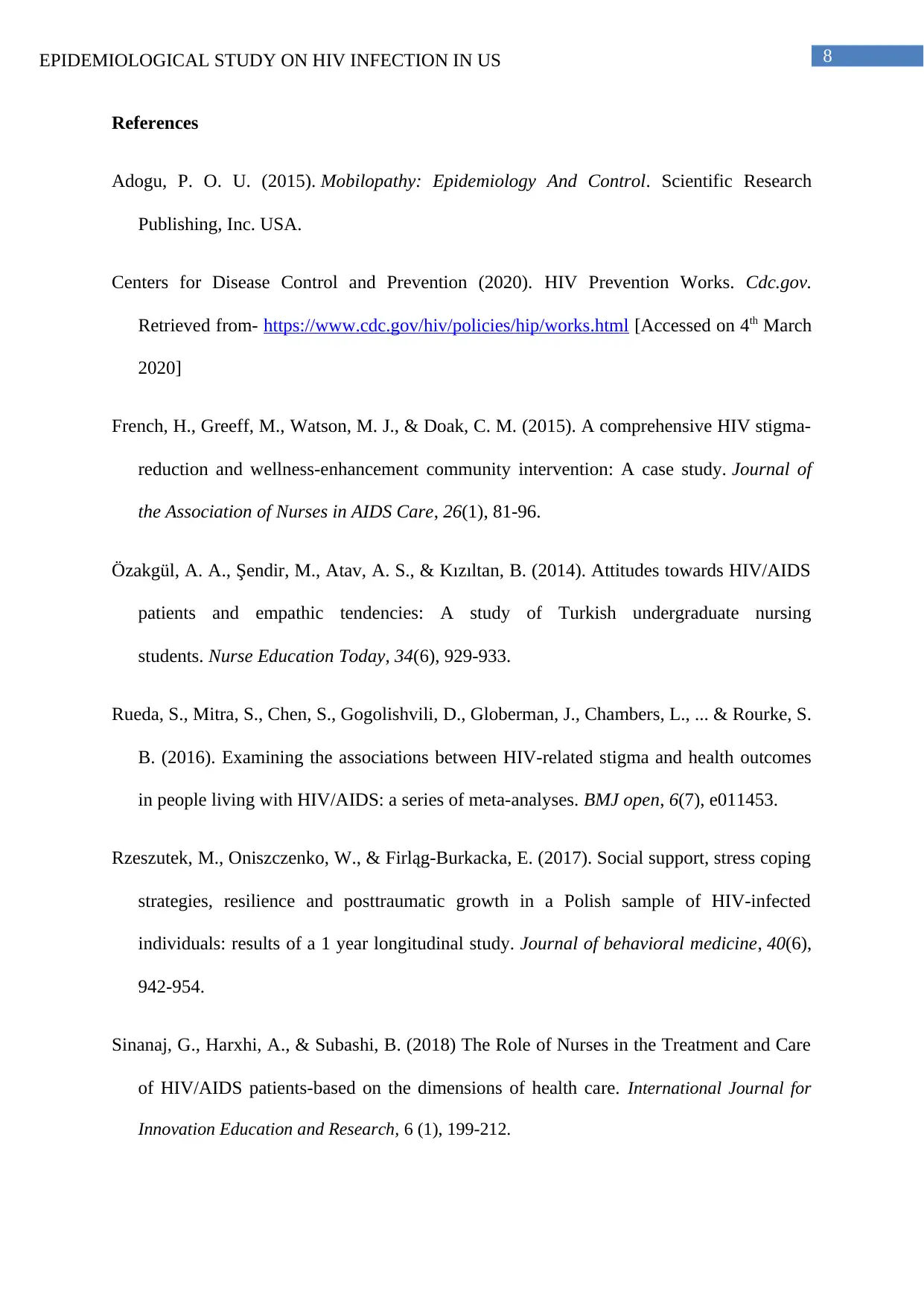
8EPIDEMIOLOGICAL STUDY ON HIV INFECTION IN US
References
Adogu, P. O. U. (2015). Mobilopathy: Epidemiology And Control. Scientific Research
Publishing, Inc. USA.
Centers for Disease Control and Prevention (2020). HIV Prevention Works. Cdc.gov.
Retrieved from- https://www.cdc.gov/hiv/policies/hip/works.html [Accessed on 4th March
2020]
French, H., Greeff, M., Watson, M. J., & Doak, C. M. (2015). A comprehensive HIV stigma-
reduction and wellness-enhancement community intervention: A case study. Journal of
the Association of Nurses in AIDS Care, 26(1), 81-96.
Özakgül, A. A., Şendir, M., Atav, A. S., & Kızıltan, B. (2014). Attitudes towards HIV/AIDS
patients and empathic tendencies: A study of Turkish undergraduate nursing
students. Nurse Education Today, 34(6), 929-933.
Rueda, S., Mitra, S., Chen, S., Gogolishvili, D., Globerman, J., Chambers, L., ... & Rourke, S.
B. (2016). Examining the associations between HIV-related stigma and health outcomes
in people living with HIV/AIDS: a series of meta-analyses. BMJ open, 6(7), e011453.
Rzeszutek, M., Oniszczenko, W., & Firląg-Burkacka, E. (2017). Social support, stress coping
strategies, resilience and posttraumatic growth in a Polish sample of HIV-infected
individuals: results of a 1 year longitudinal study. Journal of behavioral medicine, 40(6),
942-954.
Sinanaj, G., Harxhi, A., & Subashi, B. (2018) The Role of Nurses in the Treatment and Care
of HIV/AIDS patients-based on the dimensions of health care. International Journal for
Innovation Education and Research, 6 (1), 199-212.
References
Adogu, P. O. U. (2015). Mobilopathy: Epidemiology And Control. Scientific Research
Publishing, Inc. USA.
Centers for Disease Control and Prevention (2020). HIV Prevention Works. Cdc.gov.
Retrieved from- https://www.cdc.gov/hiv/policies/hip/works.html [Accessed on 4th March
2020]
French, H., Greeff, M., Watson, M. J., & Doak, C. M. (2015). A comprehensive HIV stigma-
reduction and wellness-enhancement community intervention: A case study. Journal of
the Association of Nurses in AIDS Care, 26(1), 81-96.
Özakgül, A. A., Şendir, M., Atav, A. S., & Kızıltan, B. (2014). Attitudes towards HIV/AIDS
patients and empathic tendencies: A study of Turkish undergraduate nursing
students. Nurse Education Today, 34(6), 929-933.
Rueda, S., Mitra, S., Chen, S., Gogolishvili, D., Globerman, J., Chambers, L., ... & Rourke, S.
B. (2016). Examining the associations between HIV-related stigma and health outcomes
in people living with HIV/AIDS: a series of meta-analyses. BMJ open, 6(7), e011453.
Rzeszutek, M., Oniszczenko, W., & Firląg-Burkacka, E. (2017). Social support, stress coping
strategies, resilience and posttraumatic growth in a Polish sample of HIV-infected
individuals: results of a 1 year longitudinal study. Journal of behavioral medicine, 40(6),
942-954.
Sinanaj, G., Harxhi, A., & Subashi, B. (2018) The Role of Nurses in the Treatment and Care
of HIV/AIDS patients-based on the dimensions of health care. International Journal for
Innovation Education and Research, 6 (1), 199-212.
⊘ This is a preview!⊘
Do you want full access?
Subscribe today to unlock all pages.

Trusted by 1+ million students worldwide
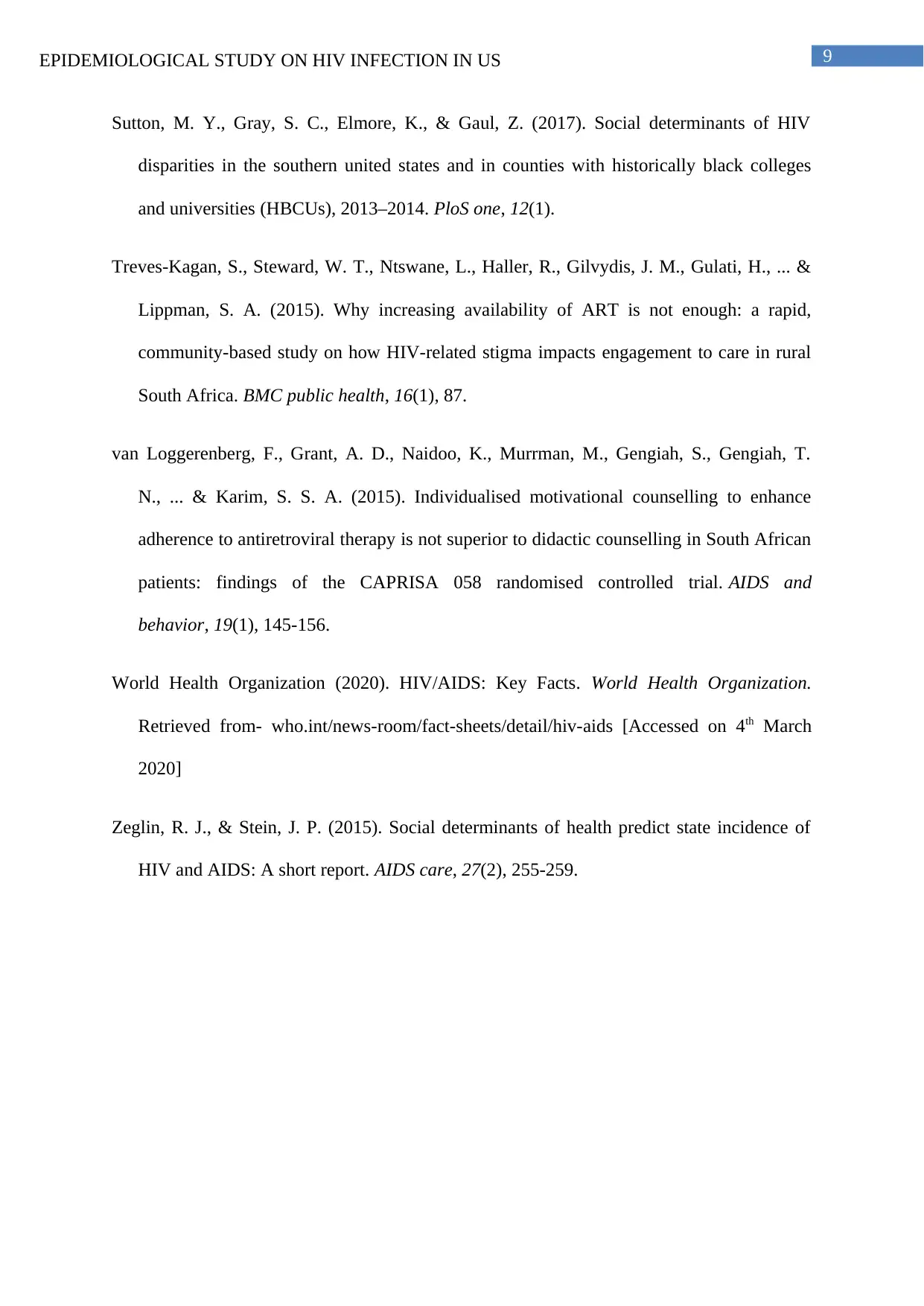
9EPIDEMIOLOGICAL STUDY ON HIV INFECTION IN US
Sutton, M. Y., Gray, S. C., Elmore, K., & Gaul, Z. (2017). Social determinants of HIV
disparities in the southern united states and in counties with historically black colleges
and universities (HBCUs), 2013–2014. PloS one, 12(1).
Treves-Kagan, S., Steward, W. T., Ntswane, L., Haller, R., Gilvydis, J. M., Gulati, H., ... &
Lippman, S. A. (2015). Why increasing availability of ART is not enough: a rapid,
community-based study on how HIV-related stigma impacts engagement to care in rural
South Africa. BMC public health, 16(1), 87.
van Loggerenberg, F., Grant, A. D., Naidoo, K., Murrman, M., Gengiah, S., Gengiah, T.
N., ... & Karim, S. S. A. (2015). Individualised motivational counselling to enhance
adherence to antiretroviral therapy is not superior to didactic counselling in South African
patients: findings of the CAPRISA 058 randomised controlled trial. AIDS and
behavior, 19(1), 145-156.
World Health Organization (2020). HIV/AIDS: Key Facts. World Health Organization.
Retrieved from- who.int/news-room/fact-sheets/detail/hiv-aids [Accessed on 4th March
2020]
Zeglin, R. J., & Stein, J. P. (2015). Social determinants of health predict state incidence of
HIV and AIDS: A short report. AIDS care, 27(2), 255-259.
Sutton, M. Y., Gray, S. C., Elmore, K., & Gaul, Z. (2017). Social determinants of HIV
disparities in the southern united states and in counties with historically black colleges
and universities (HBCUs), 2013–2014. PloS one, 12(1).
Treves-Kagan, S., Steward, W. T., Ntswane, L., Haller, R., Gilvydis, J. M., Gulati, H., ... &
Lippman, S. A. (2015). Why increasing availability of ART is not enough: a rapid,
community-based study on how HIV-related stigma impacts engagement to care in rural
South Africa. BMC public health, 16(1), 87.
van Loggerenberg, F., Grant, A. D., Naidoo, K., Murrman, M., Gengiah, S., Gengiah, T.
N., ... & Karim, S. S. A. (2015). Individualised motivational counselling to enhance
adherence to antiretroviral therapy is not superior to didactic counselling in South African
patients: findings of the CAPRISA 058 randomised controlled trial. AIDS and
behavior, 19(1), 145-156.
World Health Organization (2020). HIV/AIDS: Key Facts. World Health Organization.
Retrieved from- who.int/news-room/fact-sheets/detail/hiv-aids [Accessed on 4th March
2020]
Zeglin, R. J., & Stein, J. P. (2015). Social determinants of health predict state incidence of
HIV and AIDS: A short report. AIDS care, 27(2), 255-259.
Paraphrase This Document
Need a fresh take? Get an instant paraphrase of this document with our AI Paraphraser

10EPIDEMIOLOGICAL STUDY ON HIV INFECTION IN US

11EPIDEMIOLOGICAL STUDY ON HIV INFECTION IN US
⊘ This is a preview!⊘
Do you want full access?
Subscribe today to unlock all pages.

Trusted by 1+ million students worldwide
1 out of 12
Related Documents
Your All-in-One AI-Powered Toolkit for Academic Success.
+13062052269
info@desklib.com
Available 24*7 on WhatsApp / Email
![[object Object]](/_next/static/media/star-bottom.7253800d.svg)
Unlock your academic potential
Copyright © 2020–2025 A2Z Services. All Rights Reserved. Developed and managed by ZUCOL.





